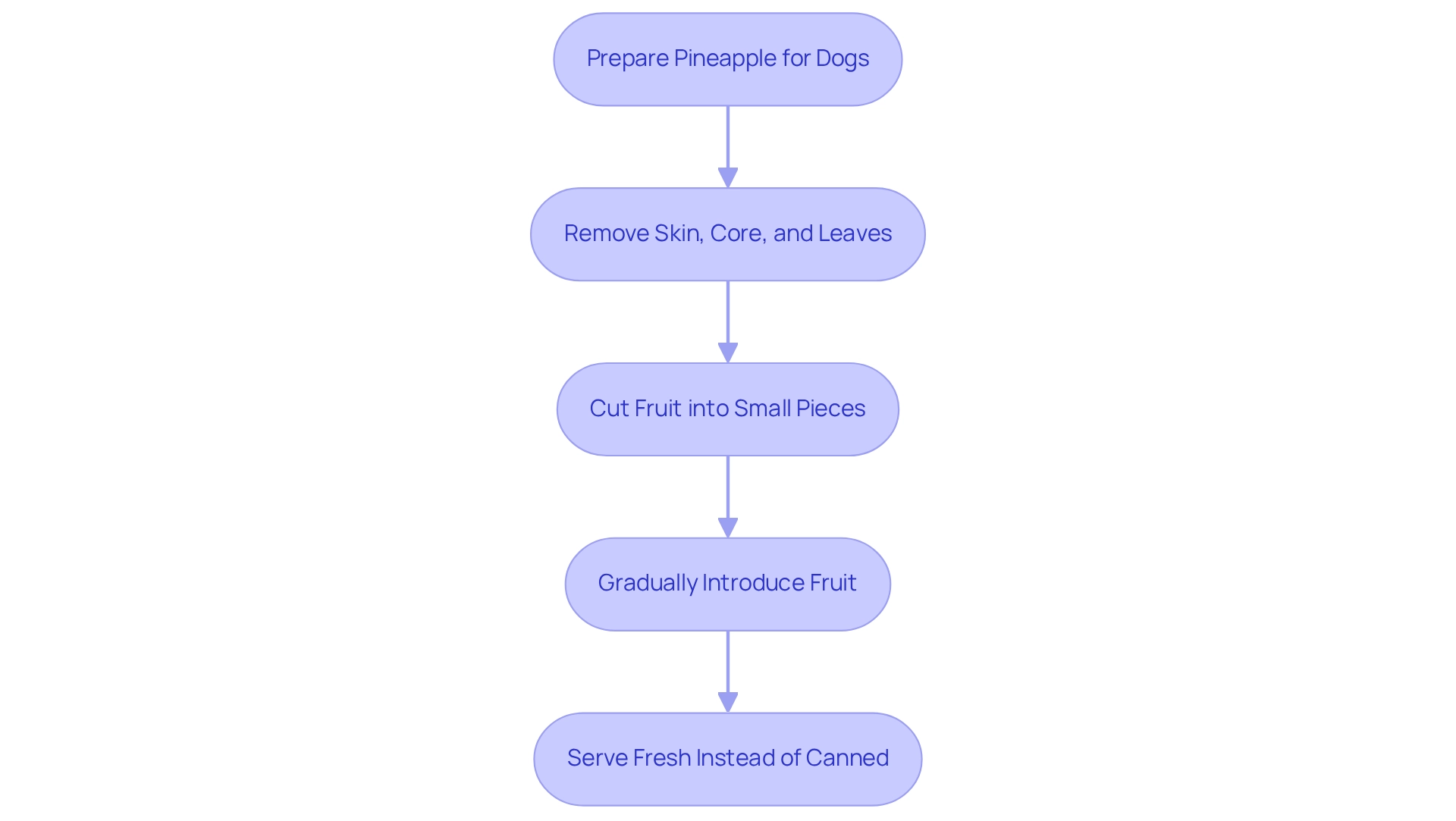

Can Dogs Eat Pineapple Skin? A Checklist for Safe Feeding
by Lena Park
Last updated: July 11, 2025
Verified and Approved by:
Angela Morris,
MSW, LCSW
Fact Checked

Overview
It’s important to understand that dogs should not eat pineapple skin, as it poses significant choking risks and can lead to potential gastrointestinal blockages. As a caring pet owner, you may be concerned about what your furry friend can safely enjoy.
While the flesh of the pineapple offers health benefits such as hydration and essential vitamins, the skin is tough and inedible. This highlights the necessity for careful preparation and monitoring when introducing new foods into your dog’s diet. Your vigilance can ensure that mealtime remains a safe and enjoyable experience for your beloved companion.
Introduction
The question of whether dogs can safely enjoy pineapple often weighs heavily on the hearts of pet owners who wish to share their favorite fruits with their furry companions. While pineapple can provide several health benefits, such as a boost in vitamin C and digestive enzymes, it is essential to recognize the potential risks associated with feeding pineapple skin.
Understanding how to assess a dog’s ability to enjoy this tropical treat, the importance of careful preparation, and the necessity of monitoring for any adverse reactions is crucial for ensuring a safe and enjoyable experience for both you and your pet.
This article explores the various aspects of incorporating pineapple into a dog’s diet, offering compassionate guidance on safe feeding practices and emphasizing the importance of moderation.
Assess Your Dog’s Ability to Eat Pineapple Skin
Please check for any known allergies your dog may have to fruits or specific ingredients. It’s important to consult with your veterinarian regarding your dog’s gastrointestinal health, as their well-being is our top priority. Additionally, take a moment to observe your dog’s past reactions to new foods, particularly those that are fibrous, to ensure their comfort and happiness.
Evaluate the Health Benefits of Pineapple for Dogs
Pineapple is a wonderful source of vitamin C, which can significantly boost your dog’s immune system, helping them stay healthy and vibrant. Additionally, it contains bromelain, an enzyme that aids digestion, making mealtime more comfortable for your furry friend. With its high water content, pineapple also provides hydration, ensuring your dog stays refreshed and energetic. Moreover, it offers dietary fiber, which can support digestive health, contributing to their overall well-being.
Identify Risks of Feeding Pineapple Skin to Dogs
Considering that pineapple skin can be quite tough, it raises concerns about whether can dogs eat pineapple skin, as it poses significant choking risks for our beloved canines, particularly if they attempt to swallow it in large chunks. Concerns arise about whether can dogs eat pineapple skin, as its consumption may lead to gastrointestinal blockages that could require veterinary attention. It’s important to note that fibrous foods are often a common cause of such blockages in dogs, highlighting the necessity for caution. Moreover, since the core and skin of the pineapple are inedible, it raises the question of can dogs eat pineapple skin, which further elevates the risk of choking and intestinal obstruction.
After ingesting fibrous substances like fruit peels, dogs may experience gastrointestinal discomfort, which can manifest as vomiting or diarrhea. It’s essential to keep a close watch for any adverse reactions and to consult a veterinarian if needed. A case study titled “Moderation in Treating Dogs with Pineapple” underscores the importance of moderation and vigilance for allergies or digestive issues when integrating this fruit into a dog’s diet.
Considering the potential risks associated with pineapple skin, it would be wise to ask if can dogs eat pineapple skin and to explore alternative fruits and vegetables that are safe for dogs and free from similar hazards. For instance:
- Apples (without seeds)
- Blueberries
- Carrots
As pet blogger Jean Marie Bauhaus wisely advises, “Just be careful not to overdo it, and don’t let your dog’s enthusiasm for this sweet treat override what’s best for their overall health.
Prepare Pineapple Safely for Your Dog
It’s important to always remove the skin, core, and leaves before feeding, particularly if you’re wondering can dogs eat pineapple skin, as this ensures a safer experience for your loved one. Cutting the fruit flesh into small, bite-sized pieces can help prevent choking, providing peace of mind. Gradually introducing the fruit allows you to monitor for any potential adverse reactions, ensuring their comfort and safety. Whenever possible, serve fresh fruit instead of canned or processed varieties, as these may contain added sugars that are less healthy.

Monitor Your Dog After Feeding Pineapple
- Observe your dog closely for any signs of stomach upset, such as vomiting, diarrhea, or changes in appetite. These signs may indicate that the fruit isn’t sitting well with your pet’s stomach.
- Pay attention to your dog’s energy levels and overall behavior after introducing fruit. If you notice any unusual lethargy or behavior, it may be time to seek further attention.
- Should your dog display any adverse reactions, like persistent vomiting or diarrhea, please consult your veterinarian immediately for guidance.
- It’s important to keep a watchful eye on your dog for at least 24 hours after adding fruit to their diet, as stomach issues can sometimes take a little time to manifest.
- According to veterinary advice, gradually introducing new foods, including pineapple, is essential. This approach allows you to assess how your dog responds while helping to prevent stomach upset.
- Research shows that digestive upset in dogs can occur in about 10-15% of cases when new foods are introduced too quickly. Therefore, moderation is key when offering this tropical fruit as a treat.
- Remember, snacks, including tropical fruits, should not exceed 10% of your dog’s daily caloric intake to maintain balanced nutrition.
- Pineapple can be a delightful addition to your dog’s meals, particularly when frozen, transforming it into a fun treat for those warm days.
- As Wellness Wag wisely states, ‘Moderation is key including fruits like tropical varieties.’ This reminder underscores the importance of mindful feeding practices. While pineapple can be a healthy addition to your dog’s diet, you may wonder if dogs can eat pineapple skin, but it should never replace a balanced diet and should be offered as an occasional treat to support your dog’s health and well-being.
Conclusion
Incorporating pineapple into a dog’s diet can offer several health benefits, such as boosting the immune system with vitamin C and aiding digestion through bromelain. However, it’s essential to approach this addition with care. The tough skin and core of the pineapple pose significant choking hazards and potential gastrointestinal issues, making it crucial for pet owners to prioritize safety when introducing this fruit.
To ensure a positive experience, it is vital to prepare pineapple properly by:
- Removing the skin and core
- Cutting the flesh into small, manageable pieces
Monitoring a dog for any adverse reactions after feeding pineapple is equally important, as digestive upset can occur, particularly if new foods are introduced too quickly. Gradual introduction and moderation are key to maintaining a balanced diet, with treats like pineapple constituting no more than 10% of a dog’s daily caloric intake.
Ultimately, while pineapple can be a delightful and nutritious treat for dogs, it should be offered with caution and care. By understanding the risks and benefits, pet owners can make informed decisions that promote their furry companions’ health and happiness. Always prioritize moderation and safety to ensure that sharing this tropical delight remains a joyful experience for both dogs and their owners.
Frequently Asked Questions
Why is it important to check for allergies before introducing new foods to my dog?
It is crucial to check for any known allergies your dog may have to fruits or specific ingredients to prevent adverse reactions and ensure their safety.
Should I consult my veterinarian before changing my dog’s diet?
Yes, it’s important to consult with your veterinarian regarding your dog’s gastrointestinal health, as their well-being is the top priority.
What should I observe about my dog before introducing new foods?
You should observe your dog’s past reactions to new foods, particularly fibrous ones, to ensure their comfort and happiness.
What are the health benefits of pineapple for dogs?
Pineapple is a source of vitamin C, which boosts the immune system, and contains bromelain, an enzyme that aids digestion. It also has high water content for hydration and provides dietary fiber to support digestive health.
How does pineapple contribute to my dog’s overall well-being?
Pineapple contributes to overall well-being by enhancing immune function, aiding digestion, providing hydration, and supporting digestive health through its fiber content.
Certify Your Emotional Support Animal Today

Why You Can Rely on Us?
At Wellness Wag, we believe your pet deserves care rooted in both science and compassion. Each article is carefully researched, written in clear language for pet owners, and then reviewed by qualified professionals to ensure the information is evidence-based, current, and practical for real-life care. Our goal is to help you feel confident in making informed decisions about your pet’s health and well-being.
Reviewed by
Angela Morris, MSW, LCSW
Angela is a licensed clinical social worker with 20 years of experience in patient advocacy and community mental health. She has assisted numerous clients with ESA evaluations and brings a deep understanding of disability accommodations, ensuring that all information is accurate, supportive, and practical.

Written by :
Lena Park
Last Updated :
July 11, 2025












